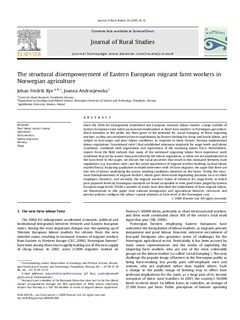| dc.description.abstract | Since the 2004 EU enlargement established one European common labour market, a large number of Eastern Europeans have taken up seasonal employment as hired farm workers in Norwegian agriculture. Much attention in the public has been given to the potential for ‘social dumping’ of these migrating workers, as they are considered prone to exploitation by farmers looking for cheap and docile labour, and subject to low-wages and poor labour conditions. In response to these threats, Norway implemented labour regulations (‘transitional rules’) that established minimum standards for wage levels and labour conditions, combined with registration and supervision of the incoming labour force. Nevertheless, reports from the field indicate that many of the westward migrating labour force experience work conditions that are far poorer than prescribed by the labour regulations, as these are not implemented at the farm level. In this paper, we discuss the social processes that result in this mismatch between state regulations (e.g. transition rules) and the actual experiences of migrant workers building on dual labour market theory. Analysing qualitative in-depth interviews with 54 farm migrants, we argue that there are two sets of factors underlying the poorer working conditions observed on the farms: Firstly, the structural disempowerment of migrant workers, which gives them weak negotiating positions vis-à-vis their employers (farmers); and secondly, the migrant workers' frame of reference for wage levels, in which poor payment levels by Norwegian standards are found acceptable or even good when judged by Eastern European wage levels. While a number of works have described the exploitation of farm migrant labour, we demonstrate in this paper how national immigration and agricultural histories, structures and present policies configure the labour–capital relations at farm level in the Norwegian case. | nb_NO |

